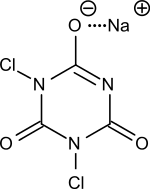Sodium dichloroisocyanurate
Sodium dichloroisocyanurate (INN: sodium troclosene, troclosenum natricum or NaDCC or SDIC) is a chemical compound widely used as a cleansing agent and disinfectant.[1] It is a colorless, water-soluble solid. The dihydrate is also known (51580-86-0 ) as is the potassium salt (2244-21-5 ).
 | |
| Names | |
|---|---|
| IUPAC name
Sodium 3,5-dichloro-2,4,6-trioxo-1,3,5-triazinan-1-ide | |
| Other names
Sodium dichloroisocyanurate, Sodium troclosene, Sodic troclosene | |
| Identifiers | |
| |
3D model (JSmol) |
|
| ChemSpider | |
| ECHA InfoCard | 100.018.880 |
PubChem CID |
|
| RTECS number |
|
| UNII | |
CompTox Dashboard (EPA) |
|
| |
| |
| Properties | |
| C3Cl2N3NaO3 | |
| Molar mass | 219.95 g/mol (anhydrous) 255.98 g/mol (dihydrate) |
| Appearance | white, crystalline powder |
| Odor | chlorine-like |
| Density | 0.7 g/cm3 (as granules) |
| Melting point | 225 °C (437 °F; 498 K) |
| 22.7 g/100 mL (25 °C) | |
| Solubility in acetone | 0.5 g/100 mL (30 °C) |
| Acidity (pKa) | 6.2-6.8 |
| Hazards | |
| Lethal dose or concentration (LD, LC): | |
LD50 (median dose) |
(Rat oral) 1670 mg/kg |
| Related compounds | |
Other cations |
Potassium dichloroisocyanurate Calcium dichloroisocyanurate Lithium dichloroisocyanurate Barium dichloroisocyanurate |
Except where otherwise noted, data are given for materials in their standard state (at 25 °C [77 °F], 100 kPa). | |
| Infobox references | |
Uses
It is mainly used as a disinfectant, biocide and industrial deodorant. It is found in some modern water purification tablets/filters. It is more efficient than the formerly used halazone water disinfectant. In these applications, it is a slow-release source of chlorine in low concentrations at a relatively constant rate. As a disinfectant, it is used to sterilize drinking water, swimming pools, tableware and air, and to fight against infectious diseases as a routine disinfection agent.
It can be used for disinfection and environmental sterilization, for example in livestock, poultry, fish and silkworm raising, for bleaching textiles, for cleaning industrial circulating water, and to prevent wool from shrinking.
In one notably interesting experiment, a concentrated solution of NaDCC and a dilute solution of copper (II) sulfate are mixed, producing an intense lilac precipitate of the complex salt sodium copper dichloroisocyanurate. The reactions between dichloroisocyanurate salts (Na, K, Li, Ba, Ca) and transition metal salts (Ni, Cu, Cd) are described in patent US 3'055'889. The overall reaction is:
- CuSO4 + 4 Na(C3N3O3Cl2) → Na2[Cu(C3N3O3Cl2)4] + Na2SO4
Sodium dichloroisocyanurate is used to show chemiluminescence as it emits red light upon decomposition by concentrated (130 vol, 35%) hydrogen peroxide.
See also
- Comet (cleanser)
- Dichloroisocyanuric acid (dichlor)
- Trichloroisocyanuric acid (trichlor)
References
- Huthmacher, Klaus; Most, Dieter (2000). "Cyanuric Acid and Cyanuric Chloride". Ullmann's Encyclopedia of Industrial Chemistry. Weinheim: Wiley-VCH. doi:10.1002/14356007.a08_191. ISBN 3-527-30673-0..